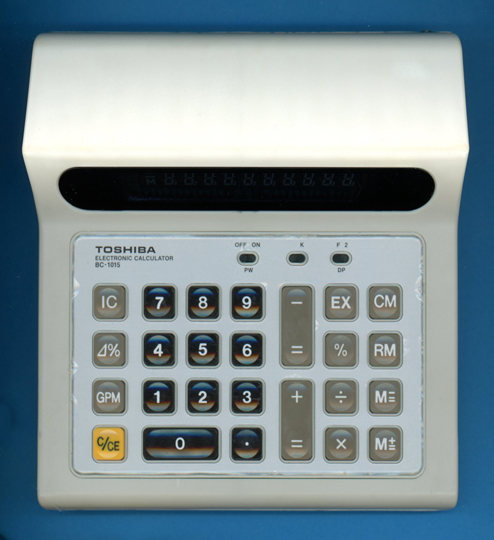
DATAMATH CALCULATOR MUSEUM
 |
DATAMATH CALCULATOR MUSEUM |
Toshiba BC-1015
| Date of introduction: | 1979 | Display technology: | Fluorescent |
| New price: | DM 75.00 | Display size: | 10 |
| Size: | 6.4" x 6.1" x 1.80" 162 x 155 x 46 mm3 |
||
| Weight: | 10.8 ounces, 306 grams | Serial No: | 10907 |
| Batteries: | 2*D Alkaline | Date of manufacture: | mth 04 year 1979 |
| AC-Adapter: | BH-126 (110V) or BH-127 (220V) |
Origin of manufacture: | Taiwan |
| Precision: | 10 | Integrated circuits: | TMC1073 (MSL 7901) |
| Memories: | 1 | Displays: | Futaba 11-BT-16A |
| Program steps: | Courtesy of: | Joerg Woerner |

![]()
 Toshiba
introduced in 1979 with this BC-1015 a very capable "Small Desktop" calculator
still sporting adding machine style [+=] and [-=] keys but featuring enhanced
functions like Delta-Percentage and Gross Profit Margin calculations and even an
Item Counter. If the keyboard layout looks somehow familiar to you, don't miss
the TI-5100 introduced four years
earlier.
Toshiba
introduced in 1979 with this BC-1015 a very capable "Small Desktop" calculator
still sporting adding machine style [+=] and [-=] keys but featuring enhanced
functions like Delta-Percentage and Gross Profit Margin calculations and even an
Item Counter. If the keyboard layout looks somehow familiar to you, don't miss
the TI-5100 introduced four years
earlier.

 Dismantling
the featured Toshiba BC-1015 manufactured in April 1979 by
Zeny Corporation in Taiwan
reveals a very clean design based on a single-sided printed circuit board (PCB)
for the main electronics connected to the keyboard and powered by two large
D-sized, disposable Alkaline batteries.
Dismantling
the featured Toshiba BC-1015 manufactured in April 1979 by
Zeny Corporation in Taiwan
reveals a very clean design based on a single-sided printed circuit board (PCB)
for the main electronics connected to the keyboard and powered by two large
D-sized, disposable Alkaline batteries.
 The
Main-PCB is centered around a TMC1073 single-chip calculator circuit, a member
of the
TMS1000 Microcomputer family introduced in October 1974 with the
SR-16 calculator. While the
TMS1000 design was mainly intended for
designs using power-hungry LED displays with external display drivers, uses the
TMS1070 redesigned output drivers for the 11 R-Outputs (Display Scan) and 8
O-Outputs (Segments) that can withstand voltages up to -35 Volts and hence allows
direct operation of low-voltage Vacuum Fluorescent Displays (VFDs).
The
Main-PCB is centered around a TMC1073 single-chip calculator circuit, a member
of the
TMS1000 Microcomputer family introduced in October 1974 with the
SR-16 calculator. While the
TMS1000 design was mainly intended for
designs using power-hungry LED displays with external display drivers, uses the
TMS1070 redesigned output drivers for the 11 R-Outputs (Display Scan) and 8
O-Outputs (Segments) that can withstand voltages up to -35 Volts and hence allows
direct operation of low-voltage Vacuum Fluorescent Displays (VFDs).
![]()
 The
BC-1015 makes fully use of the TMS1070 design and we could identify on the
Main-PCB both the voltage converter to generate a -30 Volts supply for the
Futaba 11-BT-16A VFD and the external "pull down" resistors for the R- and
O-Outputs. A very similar design was introduced already with the
TI-2550 II, the first
application of the TMS1070 chip.
The
BC-1015 makes fully use of the TMS1070 design and we could identify on the
Main-PCB both the voltage converter to generate a -30 Volts supply for the
Futaba 11-BT-16A VFD and the external "pull down" resistors for the R- and
O-Outputs. A very similar design was introduced already with the
TI-2550 II, the first
application of the TMS1070 chip.
 If
you compare this BC-1015 with the TI-5100 sporting an identical TMC1073 chip
carefully, you'll notice differences with both the number of keys and the
lettering on them and you might ask yourself: Are there even more features and
functions available with the TMC1073 chip that neither of the two calculators is
using? And how do the control a 10-segment display with just 8 O-Outputs? Hint:
Only 9 segments are used with the BC-1015. Learn
more about Characterization of Single-Chip Calculator Circuits with the
DCM-50A Platform.
If
you compare this BC-1015 with the TI-5100 sporting an identical TMC1073 chip
carefully, you'll notice differences with both the number of keys and the
lettering on them and you might ask yourself: Are there even more features and
functions available with the TMC1073 chip that neither of the two calculators is
using? And how do the control a 10-segment display with just 8 O-Outputs? Hint:
Only 9 segments are used with the BC-1015. Learn
more about Characterization of Single-Chip Calculator Circuits with the
DCM-50A Platform.
Don't miss the LC-1016 introduced in
the same timeframe.
If you have additions to the above article please email: joerg@datamath.org.
© Joerg Woerner, May 22, 2002. No reprints without written permission.